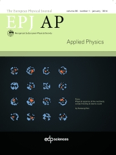
EUROPEAN PHYSICAL JOURNAL-APPLIED PHYSICS
Scope & Guideline
Innovating Research in Condensed Matter and Beyond
Introduction
Aims and Scopes
- Material Science and Nanotechnology:
The journal covers the synthesis, characterization, and application of advanced materials, including nanostructures and composites, tailored for specific applications such as energy storage, photovoltaic devices, and catalysis. - Theoretical and Computational Physics:
Research employing theoretical frameworks and computational methods, such as density functional theory (DFT), to predict and analyze the properties of materials and devices. - Plasma Physics and Applications:
Studies on the behavior and application of plasma in various contexts, including environmental technology, material processing, and biomedical applications. - Optoelectronics and Photonics:
Investigation into the optical properties of materials and their application in devices such as solar cells, sensors, and lasers, emphasizing innovations in light manipulation and energy conversion. - Energy Harvesting and Conversion Technologies:
Research focused on improving the efficiency of energy conversion methods, including solar energy, thermoelectric materials, and piezoelectric systems. - Magnetic and Electronic Properties:
Exploration of the magnetic and electronic characteristics of materials, particularly in the context of spintronics and magnetocaloric effects.
Trending and Emerging
- Hybrid and Composite Materials:
There is a growing emphasis on the development and characterization of hybrid materials, combining different components to achieve enhanced properties for applications in catalysis, energy storage, and optoelectronics. - 2D Materials and Heterostructures:
Research on 2D materials, such as graphene and transition metal dichalcogenides, and their heterostructures is rapidly increasing, highlighting their potential in electronics, photonics, and sensing applications. - Sustainable Energy Solutions:
A significant uptick in studies focused on sustainable energy technologies, including advanced solar cells, thermoelectric devices, and energy-efficient materials, reflects the global push towards renewable energy sources and sustainability. - Advanced Characterization Techniques:
Emerging trends indicate a rising interest in advanced characterization methods, such as in situ techniques and machine learning applications, which enhance the understanding of material properties and behaviors. - Functional Nanostructures for Sensing and Detection:
A notable increase in research dedicated to functional nanostructures designed for sensing applications, particularly in environmental monitoring and health diagnostics, demonstrates the practical utility of nanotechnology.
Declining or Waning
- Conventional Semiconductor Materials:
There has been a noticeable decrease in studies focusing on traditional semiconductor materials, as the field shifts towards exploring novel materials like perovskites and 2D materials that promise superior performance. - Basic Theoretical Studies Without Application Focus:
Research purely focused on theoretical aspects without tangible application has become less prevalent, as the journal pivots towards studies that demonstrate practical implications and applications of theoretical findings. - Optical Coatings and Simple Thin Films:
The frequency of publications on basic optical coatings and standard thin film technologies has diminished, likely due to the emergence of more complex and multifunctional materials that offer enhanced properties.
Similar Journals

SEMICONDUCTORS
Exploring the depths of atomic and molecular physics.SEMICONDUCTORS, published by PLEIADES PUBLISHING INC, is a prominent journal that provides a platform for researchers and professionals in the fields of Atomic and Molecular Physics, Condensed Matter Physics, and Electronic, Optical and Magnetic Materials. With an ISSN of 1063-7826 and an E-ISSN of 1090-6479, the journal has been diligently disseminating knowledge since its inception in 1996 and continues to pave the way for innovative research until 2024. Although currently unclassified in the Open Access model, its influence is underscored by its rankings in Scopus, where it ranks in the 21st-22nd percentile across critical scientific categories. SEMICONDUCTORS serves as an essential resource for cutting-edge research, fostering a greater understanding of semiconductor materials and their applications, thereby assisting the scientific community in pushing the boundaries of technology and innovation.
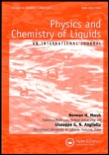
PHYSICS AND CHEMISTRY OF LIQUIDS
Transforming Understanding of Liquid BehaviorsPHYSICS AND CHEMISTRY OF LIQUIDS is a distinguished academic journal dedicated to the exploration and advancement of liquid-state scientific research within the fields of physics and chemistry. Published by Taylor & Francis Ltd, this esteemed journal features contributions that delve into various aspects of condensed matter physics, materials chemistry, and characteristics of electronic, optical, and magnetic materials. With an ISSN of 0031-9104 and an E-ISSN of 1029-0451, it has been disseminating valuable knowledge since its inception in 1968. The journal’s commitment to academic rigor is reflected in its current Q3 rankings across multiple categories, including condensed matter physics and physical chemistry. Although not open access, the journal remains a crucial resource for researchers, professionals, and students seeking to stay at the forefront of liquid research advancements. Its publications contribute significantly to the understanding of the interactions and behaviors of liquid materials, making it an indispensable asset in both academic and industrial contexts.

PHYSICA STATUS SOLIDI B-BASIC SOLID STATE PHYSICS
Driving Progress in Fundamental Material PropertiesPHYSICA STATUS SOLIDI B-BASIC SOLID STATE PHYSICS, published by Wiley-VCH Verlag GmbH in Germany, is an esteemed journal within the condensed matter physics sphere, covering pivotal advancements in basic solid state physics. With a rich history dating back to 1961, it serves as a scholarly platform for researchers, professionals, and students alike, providing insights into the fundamental properties and applications of electronic, optical, and magnetic materials. The journal currently holds a respectable Q3 ranking in both Condensed Matter Physics and Electronic, Optical, and Magnetic Materials as of 2023, indicating its impactful contributions to these fields despite its competitive landscape. While it does not offer open access, its comprehensive research findings are critical for those engaged in innovative material science research. With a convergence period extending to 2024, PHYSICA STATUS SOLIDI B continues to play a significant role in facilitating knowledge exchange and fostering advancements in solid state physics.
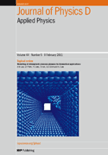
JOURNAL OF PHYSICS D-APPLIED PHYSICS
Transforming Ideas into Impactful Physics ResearchJOURNAL OF PHYSICS D-APPLIED PHYSICS is a prestigious peer-reviewed journal published by IOP Publishing Ltd, dedicated to advancing the field of applied physics since its inception in 1967. With an impressive impact factor that reflects its standing in the academic community, this journal occupies Q1 and Q2 rankings across various categories including Acoustics and Ultrasonics, Condensed Matter Physics, and Electronic, Optical and Magnetic Materials, underlining its vital role in disseminating significant research findings. The journal aims to publish high-quality original research articles, reviews, and technical notes, providing a platform for professionals, researchers, and students alike to explore a broad spectrum of topics within applied physics. With a commitment to accessibility, articles are made available for readers around the globe, ensuring that groundbreaking discoveries reach a wide audience. Located in the United Kingdom, at TEMPLE CIRCUS, TEMPLE WAY, BRISTOL BS1 6BE, the journal continues to push the boundaries of knowledge in physical sciences, making it an essential resource for anyone involved in this dynamic field.
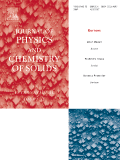
JOURNAL OF PHYSICS AND CHEMISTRY OF SOLIDS
Advancing the Frontiers of Solid-State ResearchJOURNAL OF PHYSICS AND CHEMISTRY OF SOLIDS, published by Pergamon-Elsevier Science Ltd, is a distinguished international journal that has been at the forefront of disseminating cutting-edge research in the fields of physics, chemistry, and materials science since its inception in 1956. This journal, which is recognized for its high impact in the Q2 category across multiple subjects—including Chemistry (miscellaneous), Condensed Matter Physics, and Materials Science—serves as a vital platform for researchers, professionals, and students to engage with significant advances in solid-state physics and chemistry. With Scopus rankings placing it in the top 15% of its field across various domains, the journal plays a crucial role in shaping the scientific dialogue surrounding materials properties, synthesis, and applications. Although it does not currently offer open access options, the presented research is widely recognized for its quality and relevance, ensuring that published works contribute meaningfully to ongoing scholarly discussions.

JOURNAL OF MATERIALS SCIENCE-MATERIALS IN ELECTRONICS
Unveiling Breakthroughs in Electronic Materials ResearchJOURNAL OF MATERIALS SCIENCE-MATERIALS IN ELECTRONICS, published by Springer, is a distinguished international journal that serves as a vital platform for the dissemination of cutting-edge research in the field of materials science, with a keen focus on electronics. Since its inception in 1990, this journal has consistently contributed to the advancement of knowledge across a range of interdisciplinary categories, including Atomic and Molecular Physics, Optical and Magnetic Materials, and Biomedical Engineering, achieving notable quartile positions in various 2023 Scopus rankings. With an impact factor that signifies its scholarly influence, this journal provides a rigorous peer-reviewed environment for researchers and practitioners to share innovative ideas, experimental findings, and theoretical developments. Although it does not currently offer open access options, the depth and breadth of topics covered—including condensed matter physics and bioengineering—make it an essential resource for those at the forefront of materials research. With a commitment to bridging the gap between theory and practical application, the JOURNAL OF MATERIALS SCIENCE-MATERIALS IN ELECTRONICS continues to pave the way for future explorations in the ever-evolving landscape of materials science.

ACTA PHYSICA POLONICA A
Illuminating the Path of Innovative ResearchACTA PHYSICA POLONICA A is a distinguished peer-reviewed journal published by the Polish Academy of Sciences Institute of Physics, offering a platform for disseminating cutting-edge research in the field of physics and astronomy. With an ISSN of 0587-4246 and an E-ISSN of 1898-794X, this journal has been a staple for scholars since its inception, converging its publication years from 1996 to 2024. Despite its current Q4 classification in the Physics and Astronomy (miscellaneous) category, ACTA PHYSICA POLONICA A provides valuable insights and breakthroughs addressing various aspects of general physics. Researchers, professionals, and students will find a wealth of knowledge within its pages, even as it operates in an evolving academic landscape. While subscription options exist, the journal aims to foster collaboration and knowledge exchange in the physics community, making it a vital resource for those seeking to stay at the forefront of research advancements.

SOLID STATE SCIENCES
Catalyzing Collaboration in Cutting-edge ResearchSOLID STATE SCIENCES is an influential academic journal published by Elsevier, focusing on advancements in the fields of chemistry, condensed matter physics, and materials science. With an ISSN of 1293-2558 and an E-ISSN of 1873-3085, this journal has been at the forefront of disseminating innovative research since its inception in 1999 and is projected to continue until 2024. Positioned in the prestigious Q2 category in multiple disciplines for 2023, SOLID STATE SCIENCES ranks #87 in condensed matter physics, #101 in general chemistry, and #124 in general materials science within Scopus. Researchers and professionals in these fields will find this journal indispensable, offering open access options that enhance global visibility and accessibility of cutting-edge research, fostering collaboration and innovation. With its commitment to showcasing substantial contributions and novel methodologies, SOLID STATE SCIENCES plays a vital role in shaping the future of materials research.
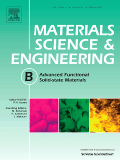
Materials Science and Engineering B-Advanced Functional Solid-State Materials
Advancing the Future of Solid-State MaterialsMaterials Science and Engineering B: Advanced Functional Solid-State Materials, published by Elsevier, stands as a pivotal platform in the realm of materials science, focusing on the development and characterization of advanced solid-state materials. With an ISSN of 0921-5107 and E-ISSN of 1873-4944, this journal operates out of the United Kingdom and addresses critical issues in condensed matter physics, mechanical engineering, and mechanics of materials. Its consistent recognition, evident in its Q2 quartile rankings across multiple engineering and physics categories and a respectable scope of convergence from 1988 to 2024, signifies its substantial contribution to the field. Researchers and professionals seeking a venue for cutting-edge work will appreciate the journal's commitment to advancing knowledge in functional materials, with its open access features ensuring that innovative findings are readily accessible. Join a community of leading scholars engaging with the latest advancements, shaping the future of materials science.
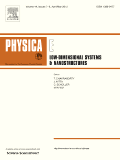
PHYSICA E-LOW-DIMENSIONAL SYSTEMS & NANOSTRUCTURES
Fostering collaboration in the world of low-dimensional physics.PHYSICA E-LOW-DIMENSIONAL SYSTEMS & NANOSTRUCTURES, published by ELSEVIER, is a premier journal dedicated to advancing the field of condensed matter and nanoscience, focusing on the innovative properties and applications of low-dimensional systems. With an esteemed Q2 ranking in multiple categories including Atomic and Molecular Physics, Condensed Matter Physics, and Nanoscience for 2023, this journal serves as a vital platform for researchers and professionals aiming to disseminate and discuss cutting-edge research. Established in 1974 and converging its focus from 1997 onwards, PHYSICA E captures the evolving landscape of material science, making it a crucial resource for anyone invested in the dynamics of electronic, optical, and magnetic materials. Although the journal operates on a subscription basis, its broad accessibility and significant placement within Scopus rankings—such as being in the 83rd percentile for Condensed Matter Physics—underscore its importance within the academic community. Researchers and students alike will find this journal a cornerstone for fostering knowledge and collaboration in the fields of nanotechnology and low-dimensional physics.